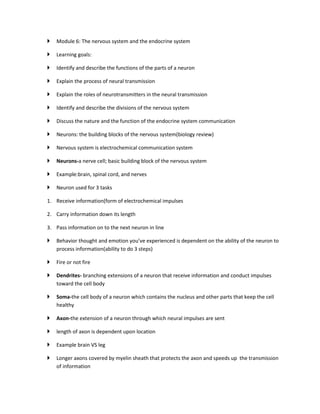
Module 6
- 1. Module 6: The nervous system and the endocrine system <br />Learning goals: <br />Identify and describe the functions of the parts of a neuron<br />Explain the process of neural transmission<br />Explain the roles of neurotransmitters in the neural transmission<br />Identify and describe the divisions of the nervous system<br />Discuss the nature and the function of the endocrine system communication <br />Neurons: the building blocks of the nervous system(biology review) <br />Nervous system is electrochemical communication system<br />Neurons-a nerve cell; basic building block of the nervous system<br />Example:brain, spinal cord, and nerves<br />Neuron used for 3 tasks<br />Receive information(form of electrochemical impulses<br />Carry information down its length<br />Pass information on to the next neuron in line<br />Behavior thought and emotion you’ve experienced is dependent on the ability of the neuron to process information(ability to do 3 steps)<br />Fire or not fire<br />Dendrites- branching extensions of a neuron that receive information and conduct impulses toward the cell body<br />Soma-the cell body of a neuron which contains the nucleus and other parts that keep the cell healthy<br />Axon-the extension of a neuron through which neural impulses are sent<br />length of axon is dependent upon location<br />Example brain VS leg<br />Longer axons covered by myelin sheath that protects the axon and speeds up the transmission of information<br />axon terminals-the endpoint of a neuron where neurotransmitters are stored <br />How do neurons communicate <br />Neuron fires<br />Action potential-a neural impulse;a brief electrical charge that travels down the axon of a neuron<br />Refractory period-the “recharging phase” during which a neuron after firing can not generate another action potential<br />Example camera flash<br /> resting potential-the state of a neuron when it is at rest and capable of generating an action potential<br />All-or-none-principle that states that if a neuron fires it always fires at the same intensity;all action potentials have the same strength<br />Example toilet<br />http://www.funnypicturefunnyphoto.com/funny-picture-photo-toilet-mural-dark-mephi.jpg<br />Communication between neurons <br />Doesn’t necessarily need 2 neurons to meet<br />Synapse-the tiny, fluid filled gap between the axon terminal of one neuron and the dendrite of another<br />Neurotransmitter-a chemical messenger that travels across the synapse from one neuron to the next and influences whether a neuron will generate an action potential<br />When action potential works towards end of neuron it causes the release of neurotransmitters from the axon terminals <br />Neurotransmitters have unique shapes and rapidly cross the synapse and fit into receptor sites on the dendrite<br />Neurotransmitters can come to rest only in receptor sites designed to fit the their shape. Once in side can serve as 2 functions:<br />1. excitatory factor-a neurotransmitter effect that makes it more likely that the receiving neuron will generate an action potential or fire<br />2. inhibitory factor-a neurotransmitter effect that makes it less likely that a receiving neuron will generate an action potential or fire<br />Example just do it or red light<br />Neural chain <br />Think of a radio station? What is the steps to hearing a song on the radio<br />Receptor cells-(antenna) specialized cells in every sensory system of the body that can turn other kinds of energy into action potentials(neural impulses) that the brain can process<br />Examples light and sound<br />sensory nerves- carry information from the sense receptors to the spianal cord and brain<br />Interneurons- nerve cells in the brain and spinal cord responsible for processing information<br />Senosry information enters the body through receptor cells<br />Brain processes the sensory info and decides what to do<br />Motor nerves receive commands from the brain and react<br />Brain determines when action is necessary to deal with incoming information<br />Brain determines course of action<br />To trigger actions the brain must get word to the body’s muscle<br />Motor nerves-nerves that catrrty information away from the brain and spinal cord to the muscles and glands<br />Structure of the nervous system <br />2 major components:<br />Central nervous system(CNS)-brain and spinal cord<br />Peripheral nervous system(PNS)-contains all sensory nerves and motor nerves that connect the brain and the spinal cord to the rest of the body<br />CNS is encased in bone for protection<br />Interneurons are responsible for processing information<br />PNS <br />PNS divides into 2 systems:<br />Somatic nervous system- division of the peripheral nervous system that controls the body’s skeletal muscle<br />Example-develop idea to walk across the classroom, CNS commands -> somatic nervous system commands legs to move<br />2. Autonomic nervous system-division of the peripheral nervous system that controls the glands and muscles of the internal organs. <br />Subdivisions of autonomic nervous system <br />sympathetic nervous system- the part of the autonomic nervous system that arouses the body to deal with perceived threats<br />Fight or flight response<br />Parasympathetic nervous system-calms the body down<br />Endocrine system <br />Besides nervous system, endocrine system is another way for communicating<br />Slower communicating system<br />Endocrine system-one of the body’s 2 communicating systems; a set of glands that produce hormones, chemical messengers that circulate in the blood<br />Hormone-chemical messengers that circulate throughout the body in the blood<br />cont <br />Hormones and neural transmitters are similar<br />Carry and communicate messages to receptor sites<br />Pituitary gland- “master gland” controls endocrine glands<br />Connected to hypothalamus<br />Work together to monitor levels of glucose<br />and insulin<br />Thyroid, adrenal glands examples<br />http://parsonsdc.com/faq.aspx <br />http://www.rmcybernetics.com/science/cybernetics/ai_vision_perception_brain.htm <br />